Impressive looking, but simple enough for beginners, this super-easy pumpkin spice soap combines pumpkin puree and goat milk with fall spices, making a soap that’s nourishing and wonderfully fragrant.
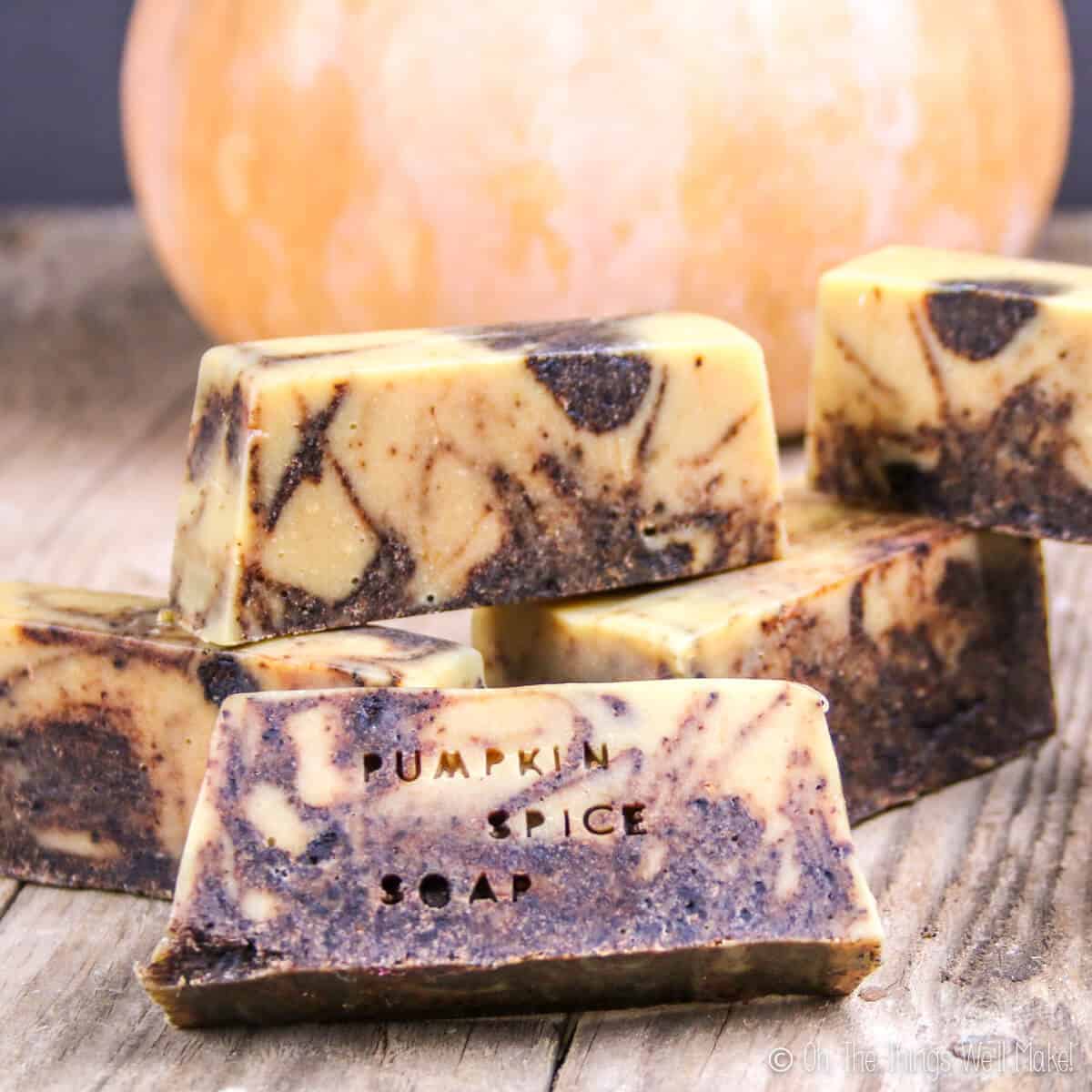
With autumn, comes cooler nights and shorter days. Halloween and Thanksgiving bring all sorts of fun pumpkin and apple spice recipes.
In celebration of this pumpkin spice time of year, I’ve decided to make a pumpkin spice soap.
What I love about this soap is that the scent lasts quite a bit longer than most naturally scented soaps. Perhaps it’s because it uses a combination of both essential oils and the actual spices. Or, maybe it’s just because the fragrance of these spices is more persistent.
Either way, I’m really happy with the final outcome.
A beginner recipe
If you have never made soap before, don’t worry. This soap is very simple to make. I purposely based this soap recipe on my easy, beginner soap recipe.
Because this recipe uses milk and adds a swirling technique, it is a bit more complicated than the other recipe. If that worries you, begin with the other recipe. If you’re adventurous, though, give this one a try! By following the directions carefully, even as a beginner, you shouldn’t have any problems.
My beginner soap is a tried and true recipe that only uses simple, easy-to-find oils. It also has a relatively long working time. The longer working time is perfect for beginners because it gives plenty of time to add in fragrance oils and spices. You should also have time to spare to swirl them together as I did.
To show how simple it is to adapt a soap recipe, I kept the main recipe exactly as it was. So, this recipe uses the same basic oils in the same amounts as the original recipe. For that reason, it also uses the same amount of lye and a similar amount of water. (This time, though, I switched out half of the water for goat milk. I also reduced it slightly because of the water in the pumpkin puree.)
Introducing new soap techniques
The beginner soap is great, but it’s also rather basic. I often get questions from readers who love that recipe, but who want to incorporate other ingredients. Today we will cover some of the ways to customize a recipe without changing the main recipe.
Adding goat’s milk
Rather than only use water, I decided to add some goat milk to this recipe. Goat’s milk is a very popular ingredient for soap because it is gentle and nourishing to the skin.
Making soap with goat’s milk isn’t just as simple as switching out the water for milk, though. Milk is a great ingredient because it has nourishing fats. Milk also has sugar in it, though, and the chemical reaction of those sugars with the lye can cause it to burn. That can leave your soap with an unpleasant scent and/or brown color.
To prevent that from happening, the milk should be added at a very cold temperature. This can be done by mixing it over an ice bath or even freezing the milk first.
Swirling technique
I also made this soap different from the basic recipe by using a swirl technique to give a fun, marbled appearance to the soap.
This soap is completely natural, but still has a fun look to it. The main soap mixture has the goat milk and a homemade pumpkin puree. (While it’s simple to make, you can also just use canned pumpkin instead.) To make the swirl, we’ll separate out some of the soap mixture and add our ground, dried spices into only one of the parts. The spices add a dark color to the soap, along with a beautiful aroma, and also add a very mild exfoliation.
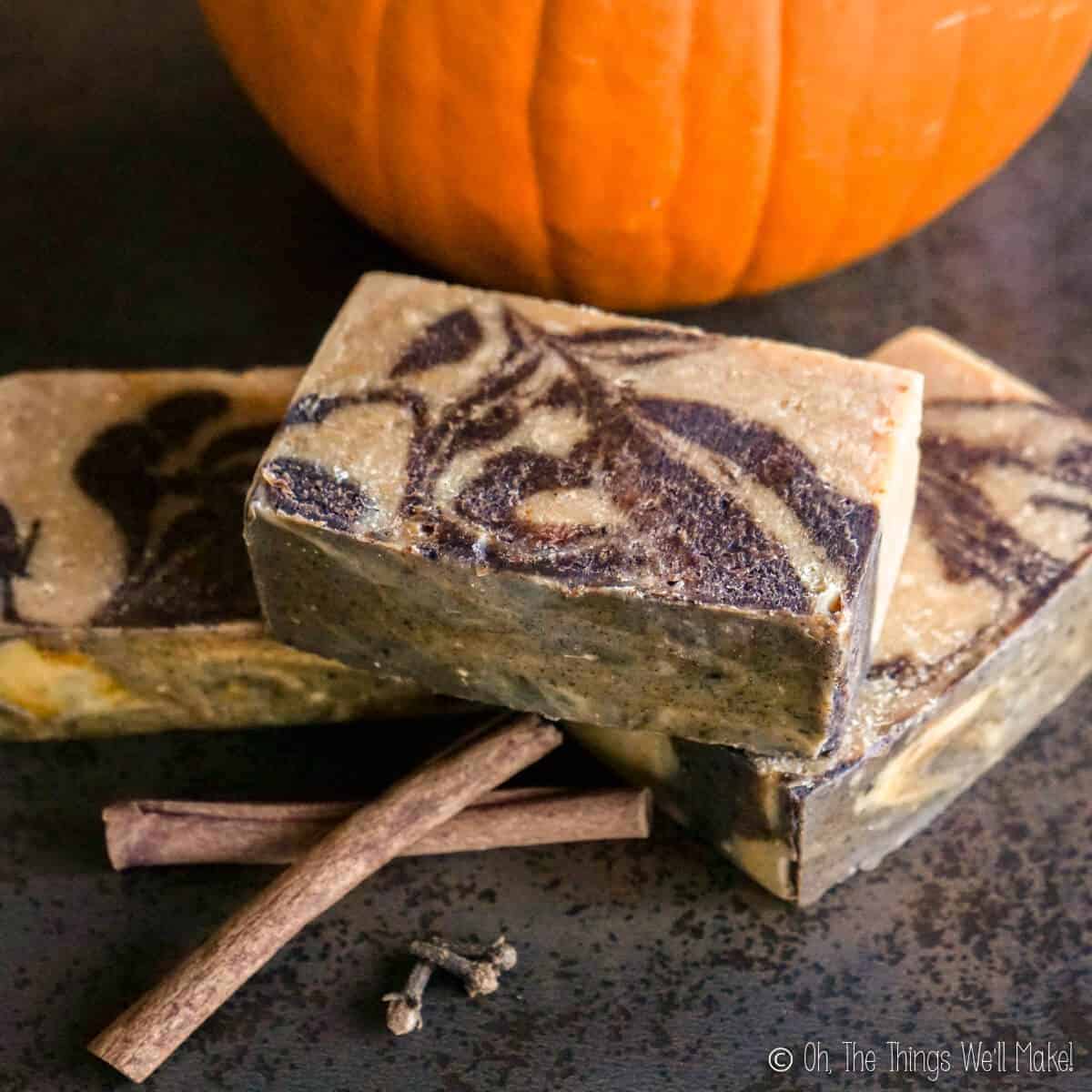
By swirling the spiced soap into the unspiced pumpkin soap, you end up with a pretty marbled looking soap. Some people make elaborate swirl designs with their soaps, incorporating a lot of bright colors. For today, though, we’ll start simple.
No matter what happens with your swirling, this soap should come out looking great. (I’m always a bit nervous about how it will turn out, but I’m also always pleasantly surprised by the outcome.)
Ingredients
Like the easy, beginner soap, the main base of this soap is made with olive oil, coconut oil, lye, and water.
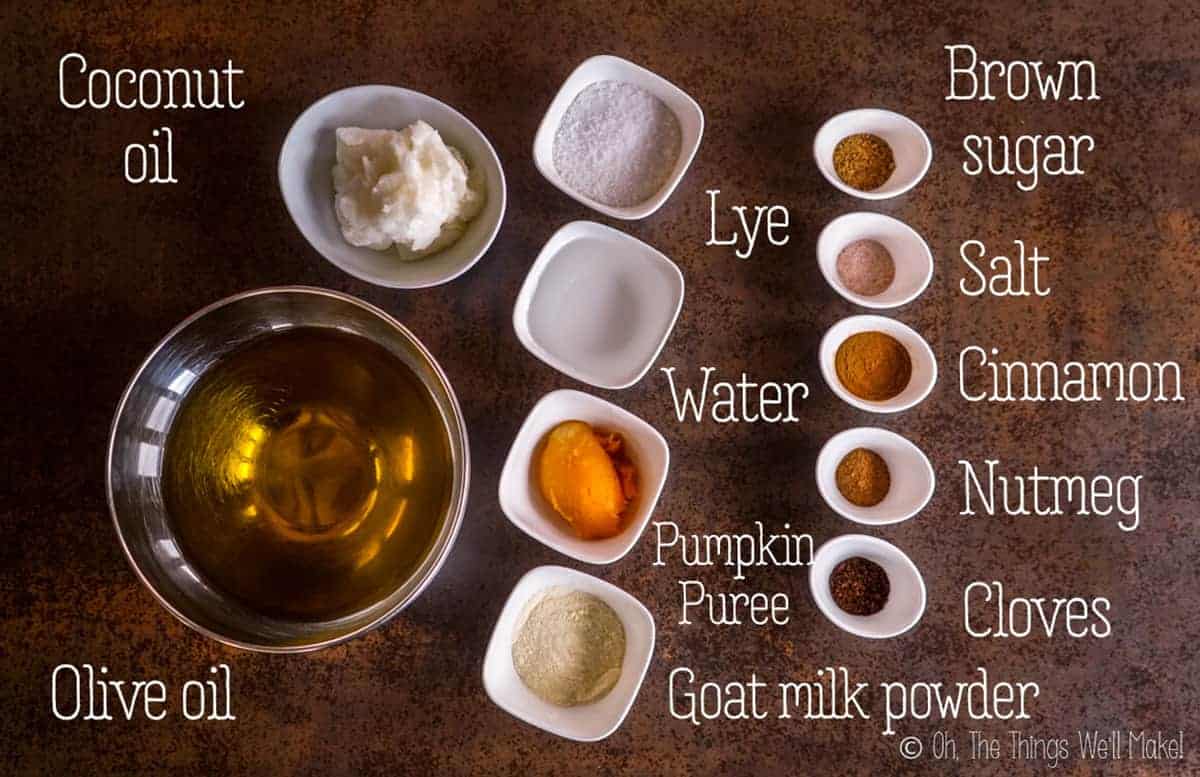
To give this soap more of an autumn touch, I added some pumpkin puree. While you could use canned pumpkin, it’s very simple to make a homemade pumpkin puree that is perfect for all sorts of recipes this time of year!
For creaminess, and to help nourish the skin, I also added goat’s milk. Pumpkin and goat’s milk both add a little color to the soap, and they also add some hydration and richness.
To add some more color and a beautiful scent, I added some pumpkin spices. While I could have stuck with just using essential oils, I chose to also add the ground, dried spices themselves to part of the recipe. That allowed me to show you how to make a simple swirling pattern for a homemade soap.
Procedure
This soap may look complicated, but it’s really quite simple. First, mix the lye solution with frozen goat’s milk.
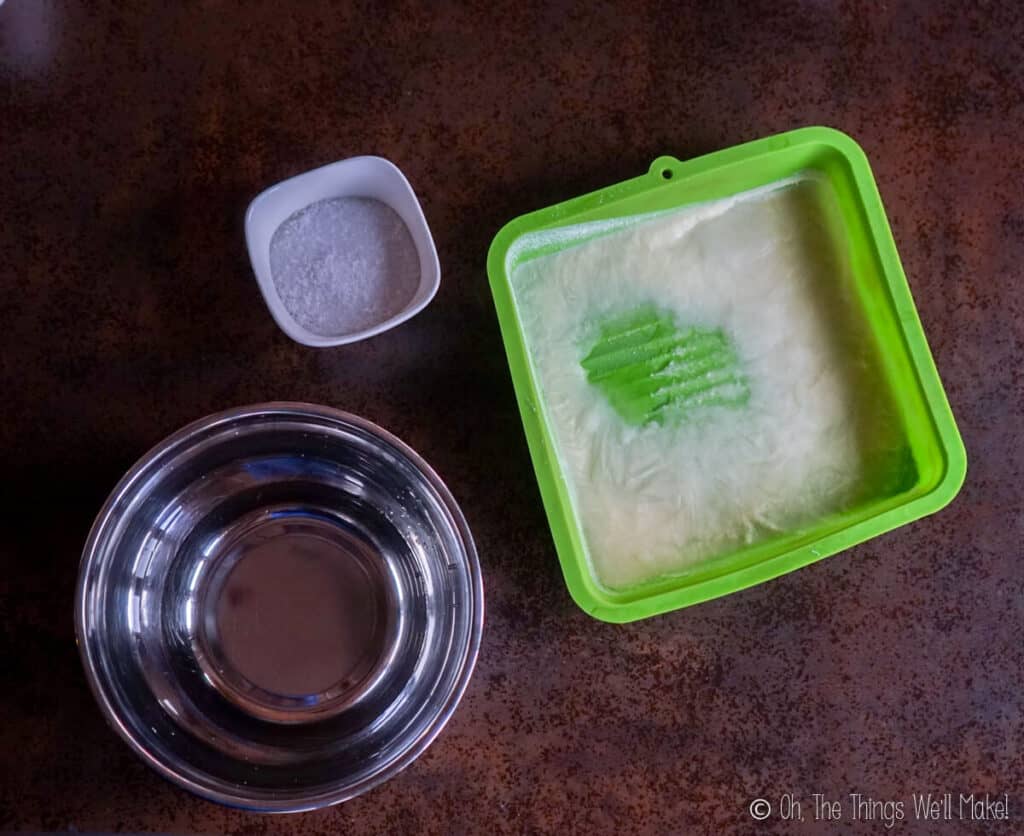
Lye, water, and frozen goat milk 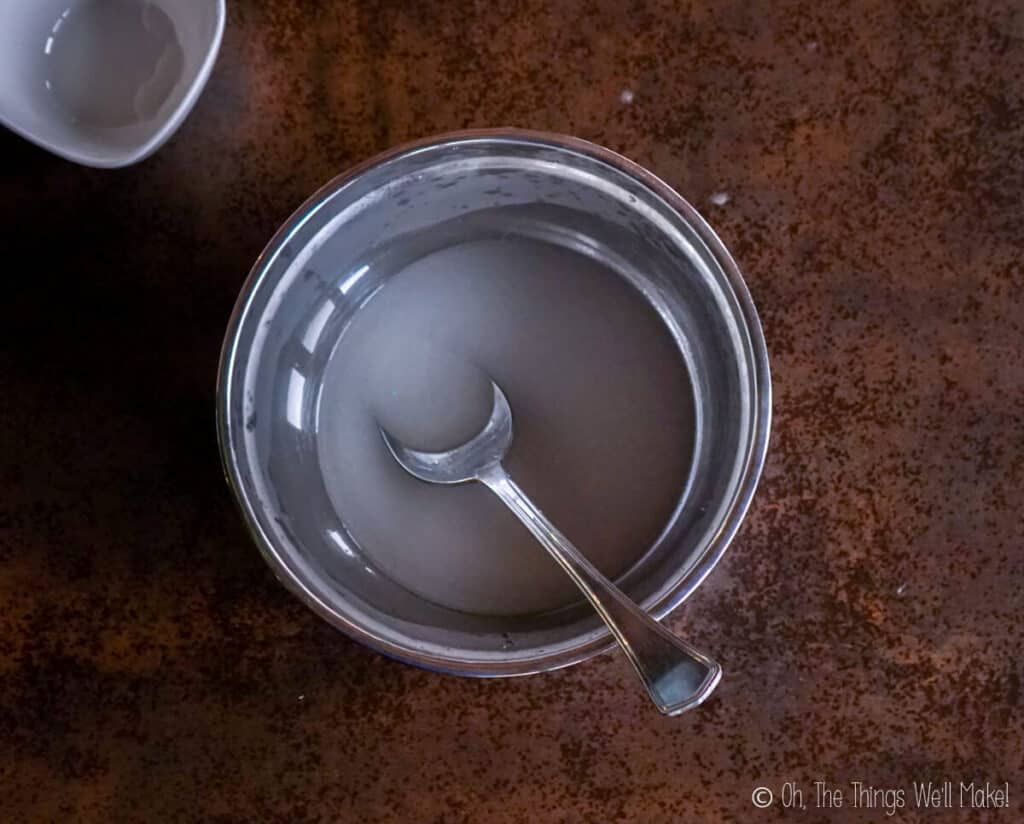
Lye solution (water with lye) 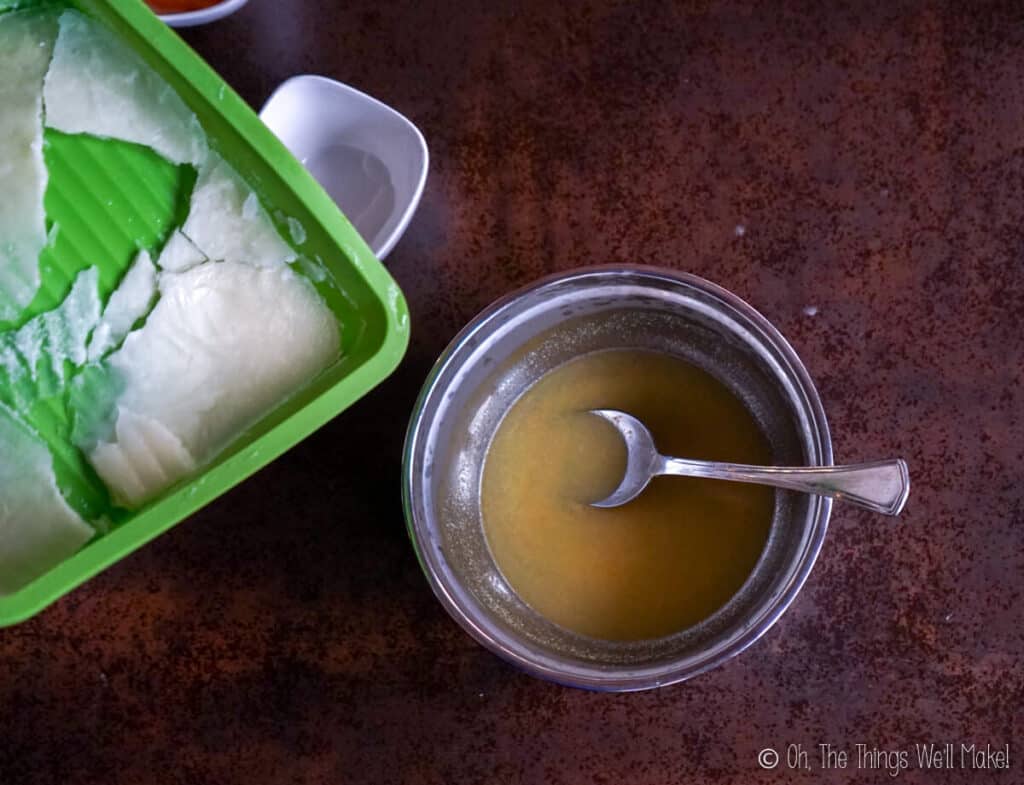
Add the frozen milk 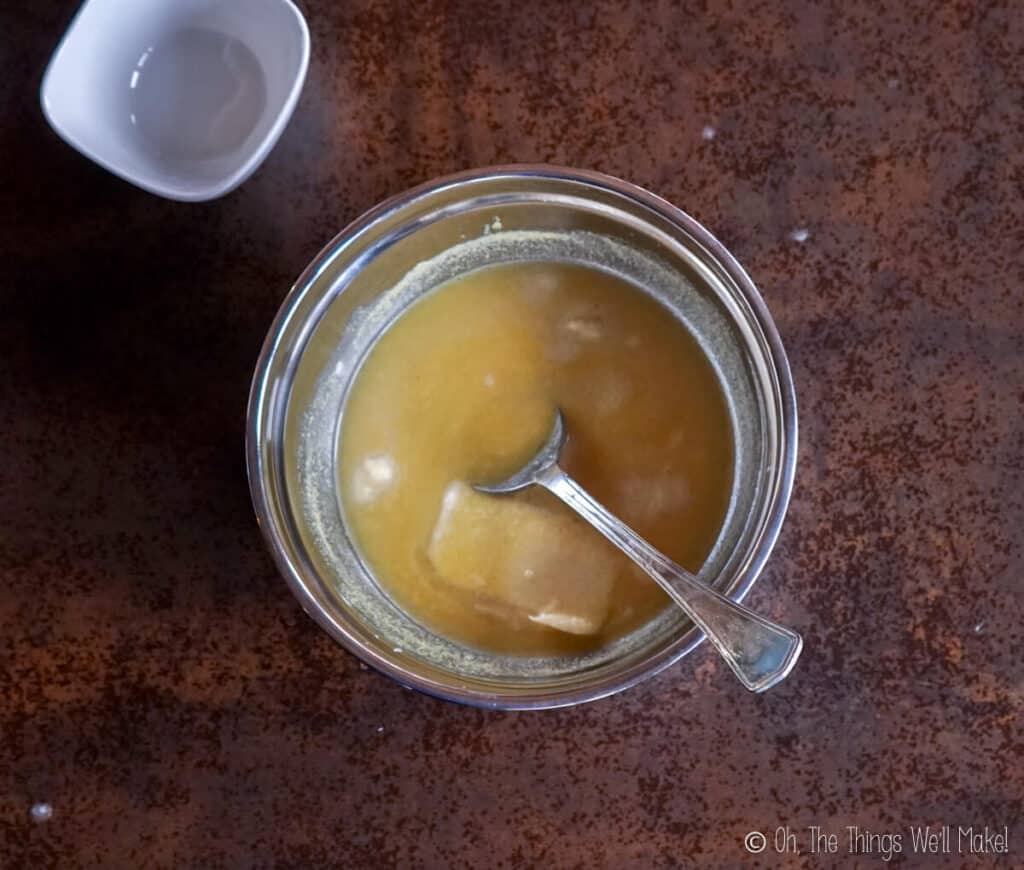
Then blend that mixed solution into the oils.
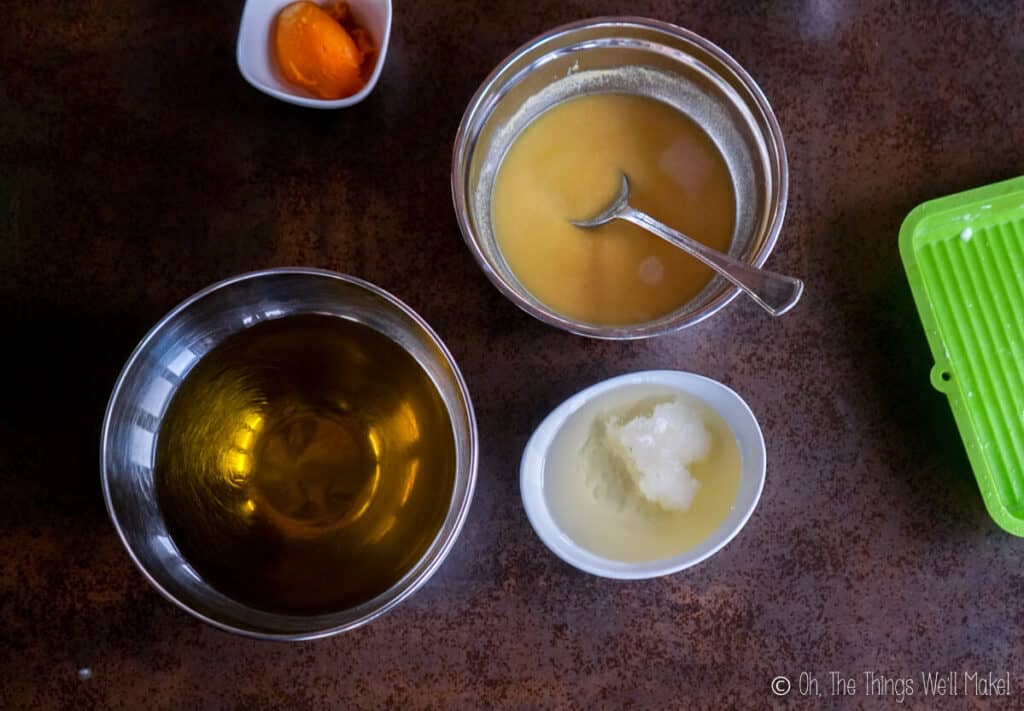

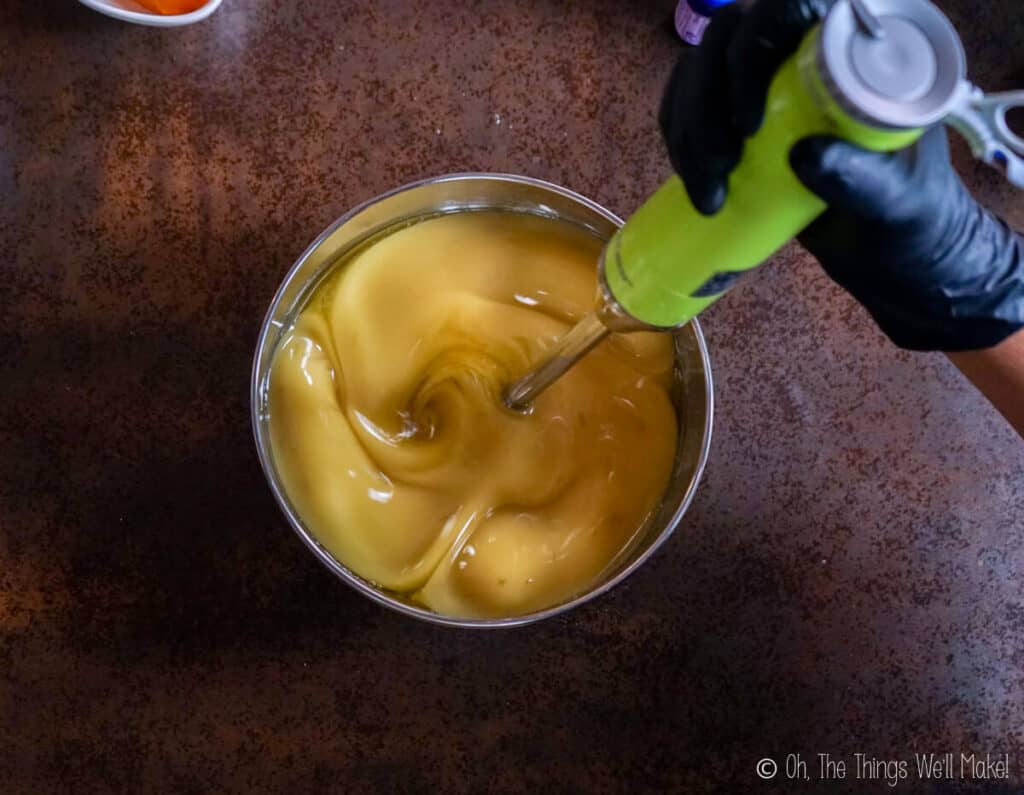
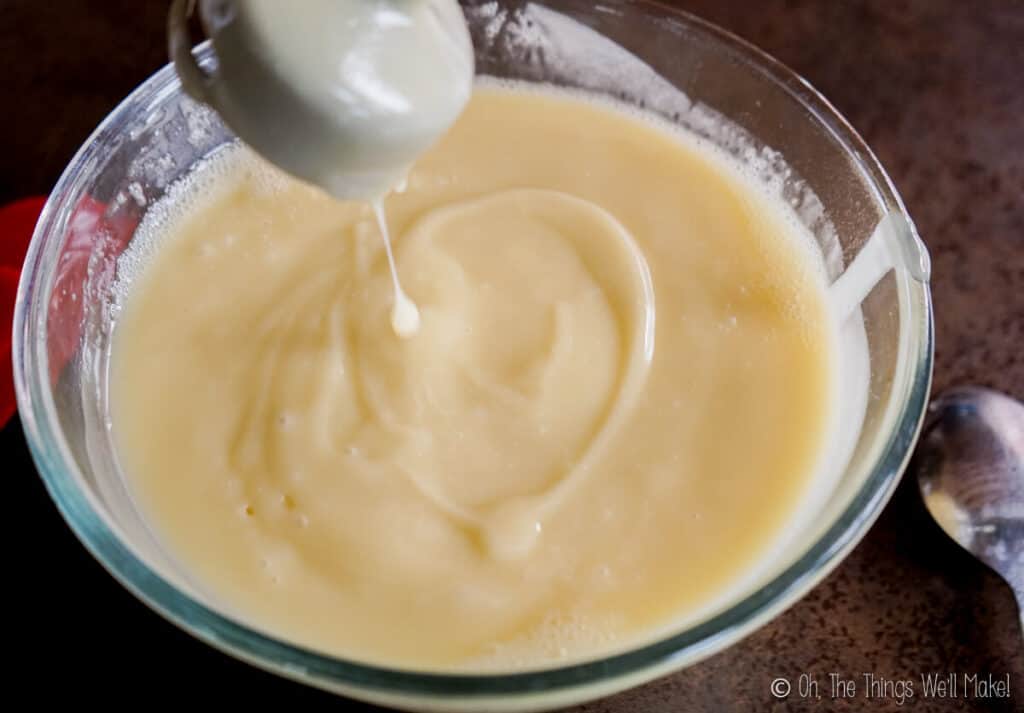
Soap at “trace”
Once we reach “trace” (when the soap is fully emulsified and looks like a thin mayonnaise), we will add our pumpkin and fragrance oils.
Then, we’ll separate around ⅓ of the mixture into a separate bowl.
At this point, we’ll add the ground spices into the soap mixture that we just separated out.
Once we have our two soap mixtures ready, we can begin to fill our soap mold. (I’m using a silicone loaf pan.) Pour half of the unspiced mixture into the mold, followed by half of the spiced, the rest of the unspiced, and finishing with a layer of spiced soap mixture.
To swirl the soaps, place a stainless steel spoon (or another utensil) into the soap.
Allow the soap to set untouched for around 24 hours. Once it’s hard enough to unmold it, gently remove it from the mold and cut it into bars.
That’s all there is to it. You should let the bars of soap cure for around 3-4 weeks before using them. (During that time, they will harden and improve.)
Customizing the recipe
Even this recipe can be slightly customized to suit your taste.
Adding color
I originally left this soap its natural golden color. This year, though, I wanted to try something new and incorporate a natural orange color by adding some ground achiote to the soap. Unfortunately, when I was ready to make it, I realized I didn’t have any on hand. So, I used paprika instead. Paprika is another way to naturally color the soap, but it doesn’t turn as orange as it would with achiote powder.
Other changes
Don’t want to use goat milk? Just switch it for another 100ml of water.
If you don’t want to do the swirl technique, you can either add the spices to all of the soap (which will result in a brown soap) or don’t use ground spices at all (for a golden colored soap).
Safety Tips
As with all soap recipes, be very careful when working with the lye solution.
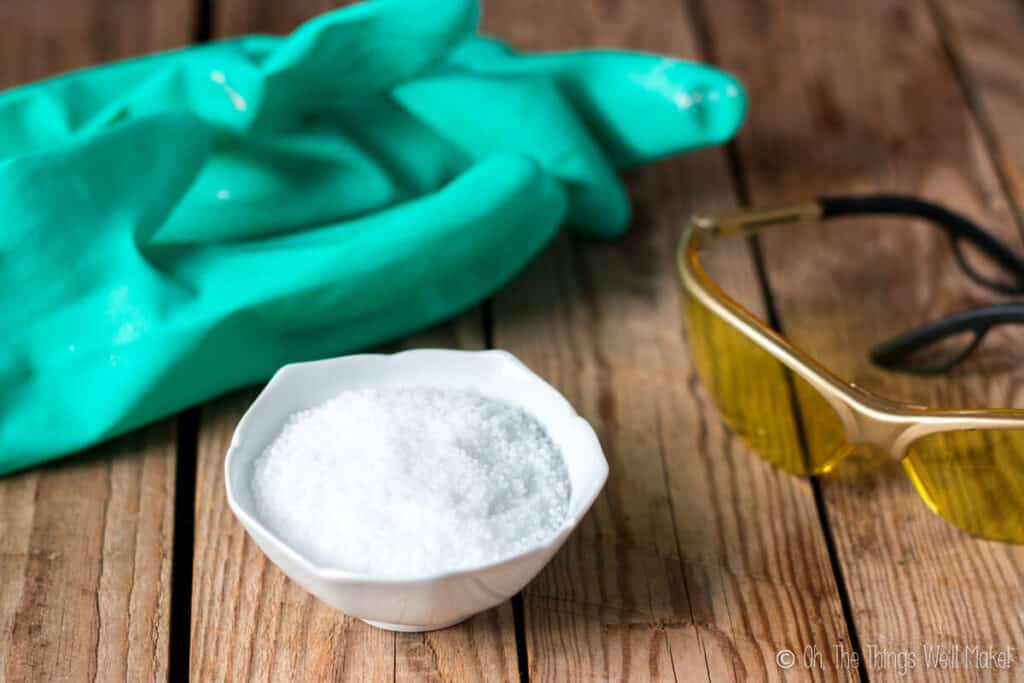
- When making soap, use protective eyewear and gloves. To make the lye solution, pour the lye into the water rather than the other way around!
- Mix the ingredients together outside or in a well-ventilated area. For more safety tips, read my beginner soap recipe post.
Video
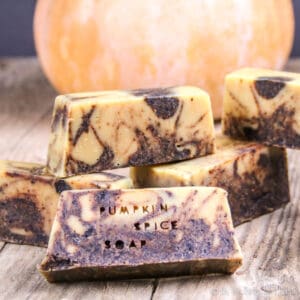
Easy Pumpkin Spice Soap
Materials
- 100 g coconut oil
- 500 g olive oil
- 80 g lye 2.8 oz.
- 100 ml goat milk either fresh or reconstituted from powdered
- 100 ml water
- 45 g pumpkin 1.6 oz., I made my own puree
- 1 teaspoon coconut sugar or any brown sugar
- 1 teaspoon salt
- 1 Tablespoon cinnamon
- 1 teaspoon nutmeg
- 1 teaspoon ground cloves
- clove essential oil & cinnamon and ginger essential oils
Instructions
Prepare the goat milk
- Place the goat milk in the freezer while weighing/measuring out the other ingredients. (You'll want to have the spices ready to go so that you aren't rushed later on.)
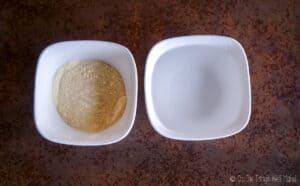
Prepare the lye solution
- Carefully pour the lye into the water in a stainless steel or plastic bowl. (For more safety tips, read my easy beginner soap recipe post.) Mix in a well-ventilated area. The mixture will heat up and become cloudy. Try to dissolve all (or most) of the lye before adding in the goat milk.
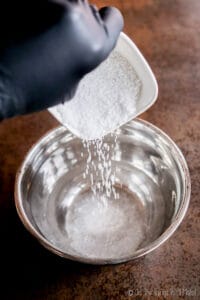
- After a few minutes, begin adding the cold goat milk. I like to add it when it's frozen to avoid scorching the milk. If your milk isn't frozen, you can also mix them together over a pan of ice and water. Your solution will probably yellow. That is a normal reaction of goat milk and lye.
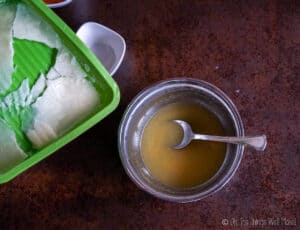
- Add the sugar and salt to the lye solution. Once the solution is thoroughly mixed, allow it to rest while you get together the other ingredients.
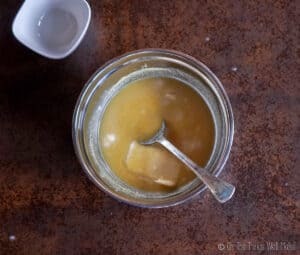
Combine the lye solution and the oils
- Melt the coconut oil if it is in a solid state. Then, combine the oils in a large bowl.
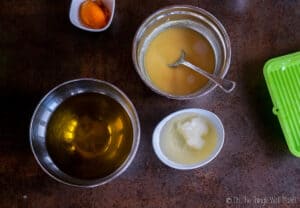
- Add the lye solution to the oil mixture, and gently mix them together.
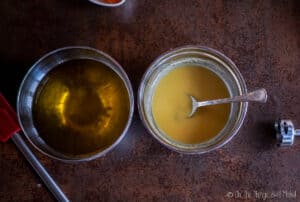
- Once the lye solution is incorporated into the oils, carefully mix them together with an immersion blender. The mixture will become creamy looking and, after a few minutes, will thicken into a thin, mayonnaise-like texture. (If your ingredients are cold, it will take a bit longer.) At this point, it's called "trace." We can now add in other ingredients.
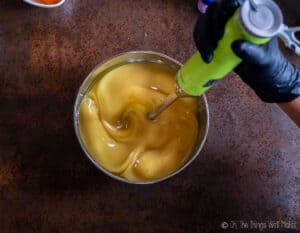
Add in other ingredients
- Add the pumpkin puree to the soap mixture. If you want to add an orange pumpkin color, now is the time to add in some achiote powder (start by mixing in a small amount and add more as desired) or a soap colorant.
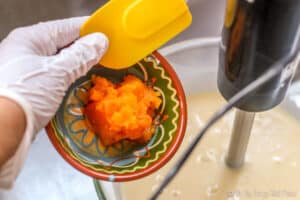
- Add the essential oils or cosmetic grade fragrance oils, if you prefer. Certain essential oils, like clove oil, may cause your soap to thicken more quickly, so be prepared, just in case. I didn't find it to be an issue, but it may depend on the oil. You can experiment here, and use your nose to help guide you. I used mostly clove oil, followed by some cinnamon and ginger oil. 😉
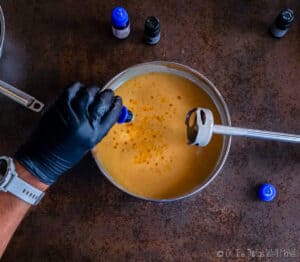
- Separate out about ⅓ of the soap mixture into a separate bowl. Add the ground dried spices to the ⅓ that you separated out. Mix well to fully disperse them in the mixture.
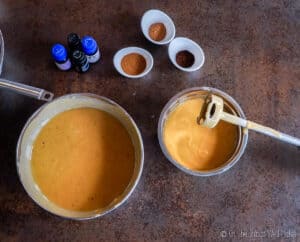
Pour into molds
- Pour about half of the un-spiced soap mixture into your mold. (I'm using a silicone loaf pan.)
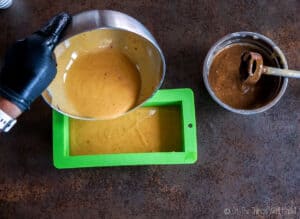
- Add a layer of the spiced soap using about ½ of the spiced soap mixture. If it appears to fall to the bottom in one area, carefully spoon it over the top to completely cover the unspiced layer.
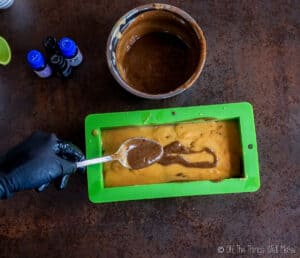
- Cover that layer with another layer using the rest of the un-spiced soap mixture. Then, cover that, as before, with the rest of the spiced soap.
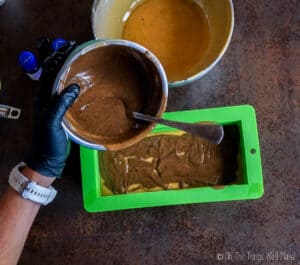
Swirl the soaps
- Using a spoon or some other utensil, poke into the soaps, reaching for the bottom layer and pulling the soap out over top, trying to gently swirl the soaps in certain places. You can also zigzag your way through the soap in places, to have the soaps gently swirl together, without fully mixing them into each other.
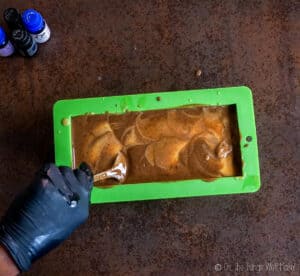
- Once you've gently swirled all over the soap, allow the soap to rest for at least 24 hours.

Unmold and cut the soap
- After 24 hours, you can begin to check the soap to see if it's hard enough to be gently unmolded. If it is too soft, wait another day and check on it again. Once hard enough, gently unmold it. (Don't wait too many days or it may be difficult to cut into bars.)
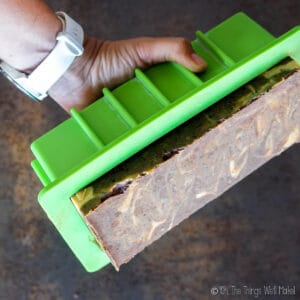
- Once you've removed the block of soap from the mold, cut it into bars. You can make your soaps as thin or as thick as you like.

Curing the soap
- Place the soap on parchment paper or cardboard with air space between the bars. Allow them to cure for several weeks, ideally at least 3-4 weeks. During this time, the soap will harden and the crystalline structure will continue to form. To help the soaps dry thoroughly on each side, flip the bars of soap every couple of days at first. Once cured, it's ready to use like any other soap. Enjoy!
 Español
Español
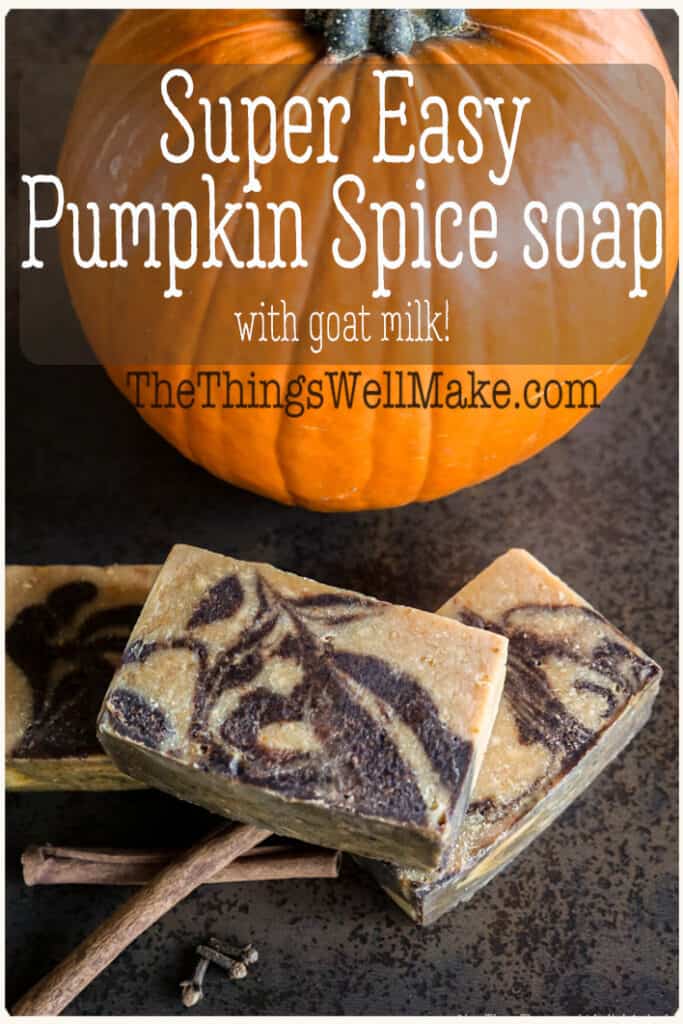
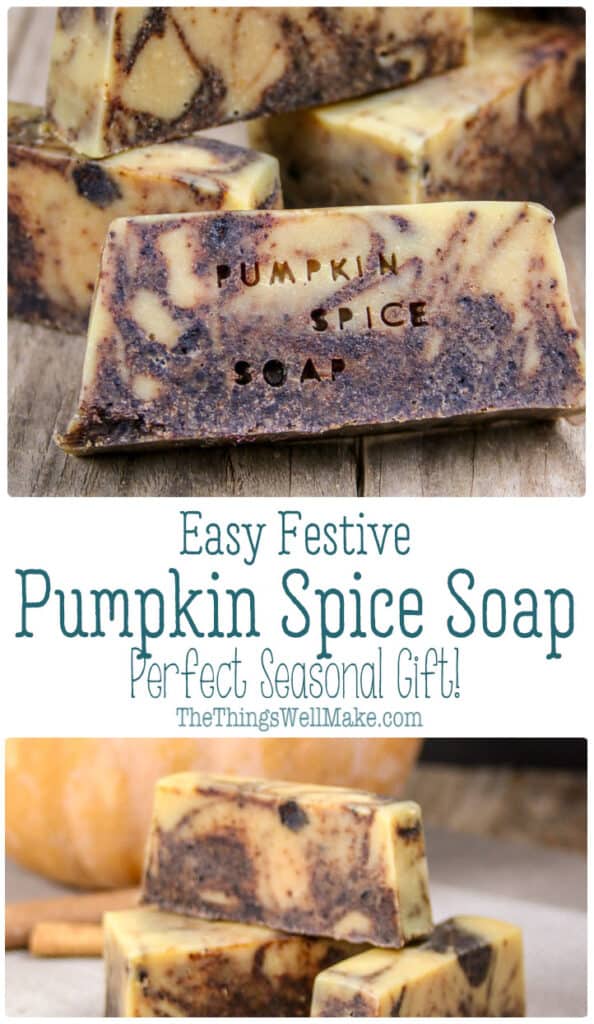
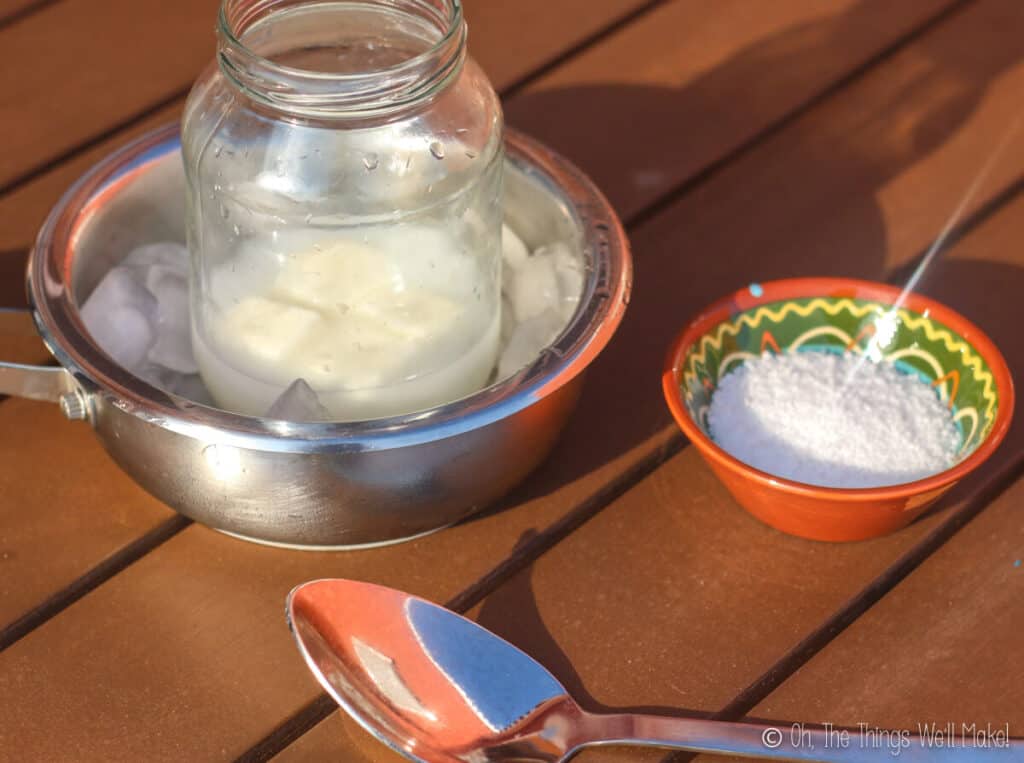
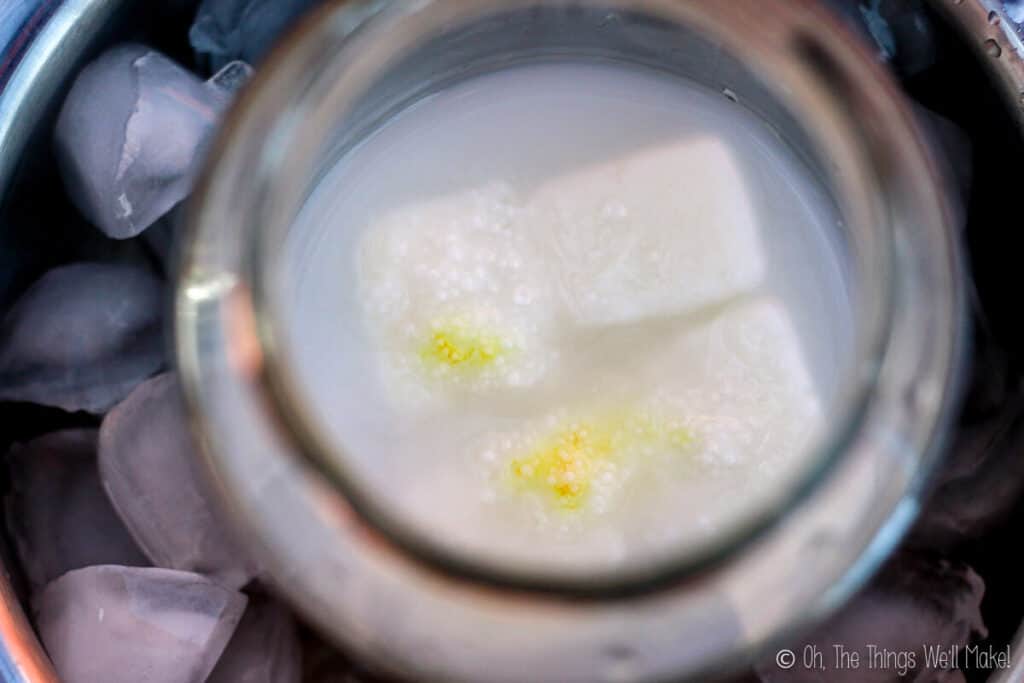
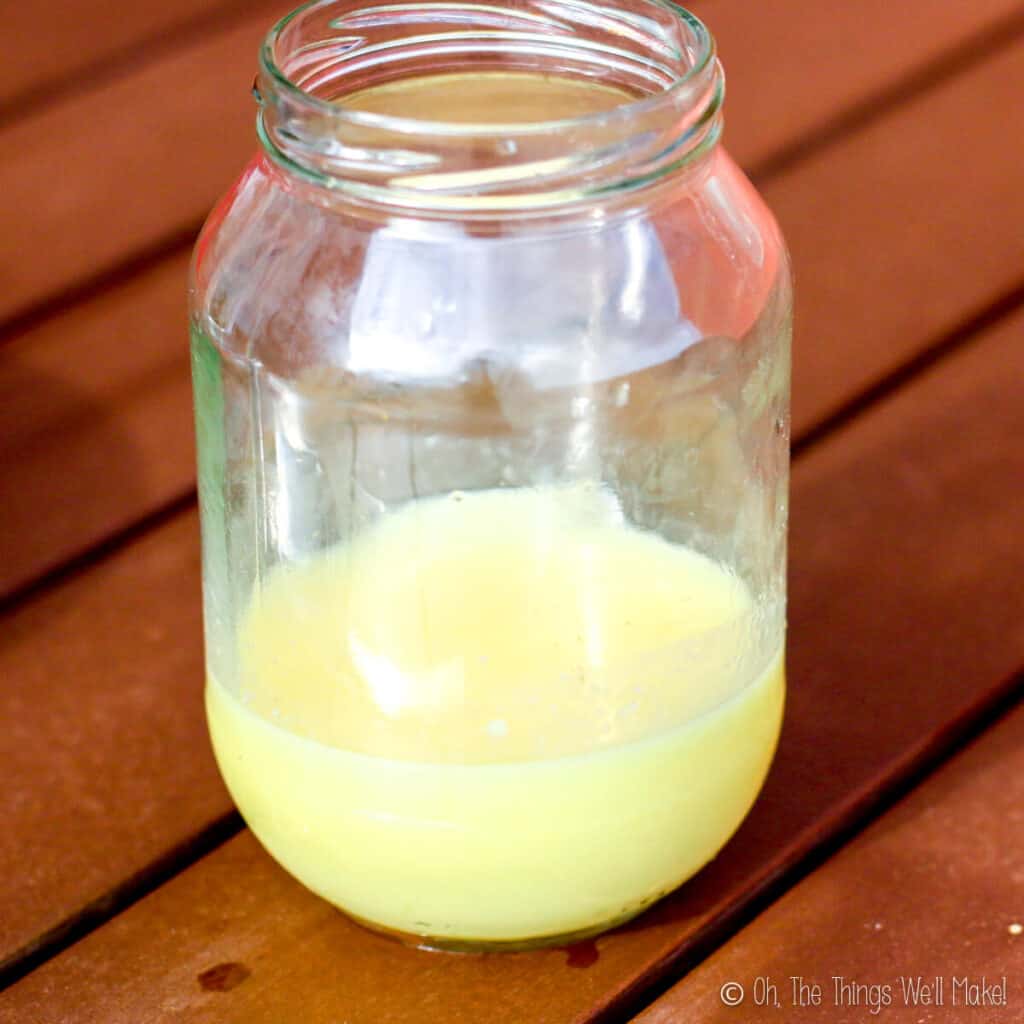
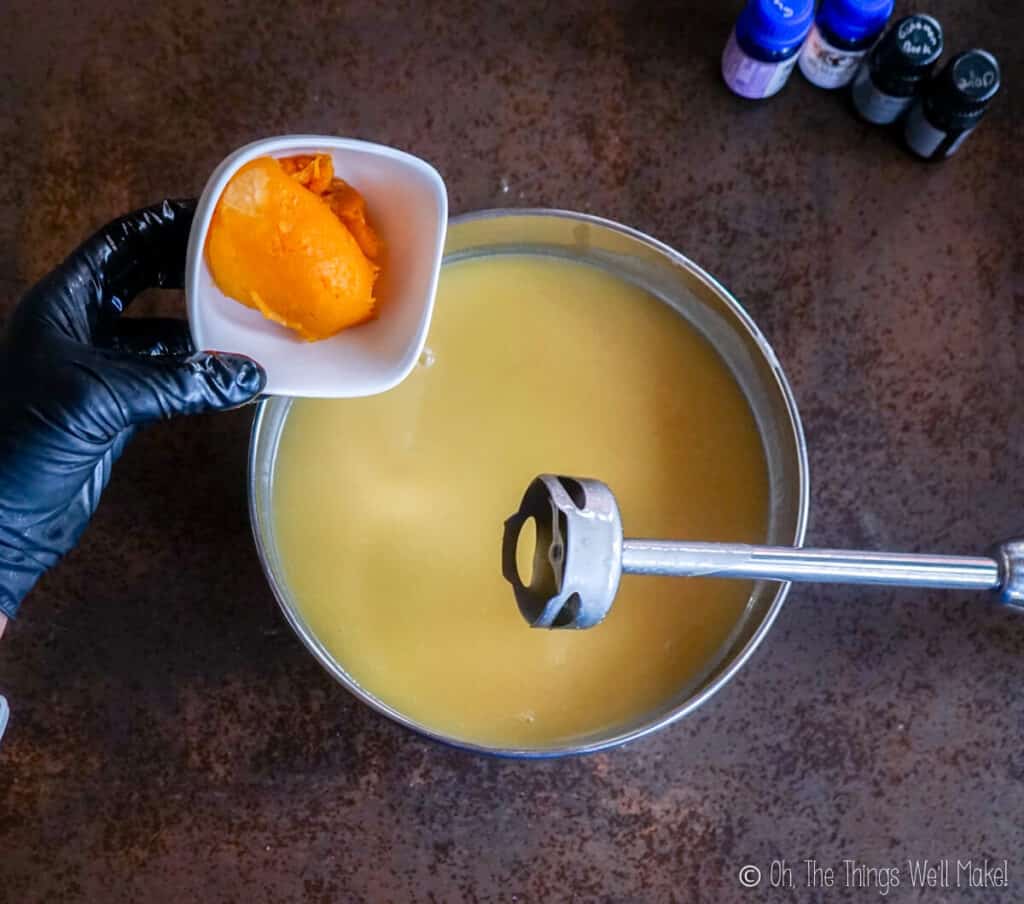
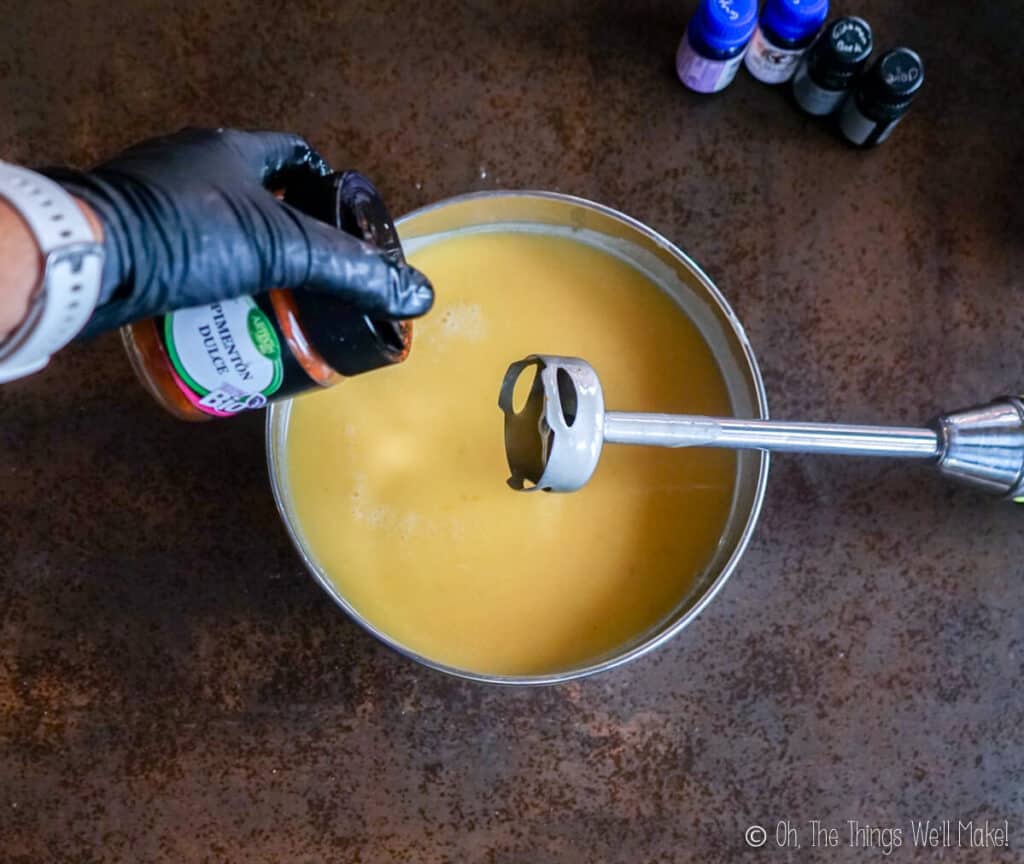
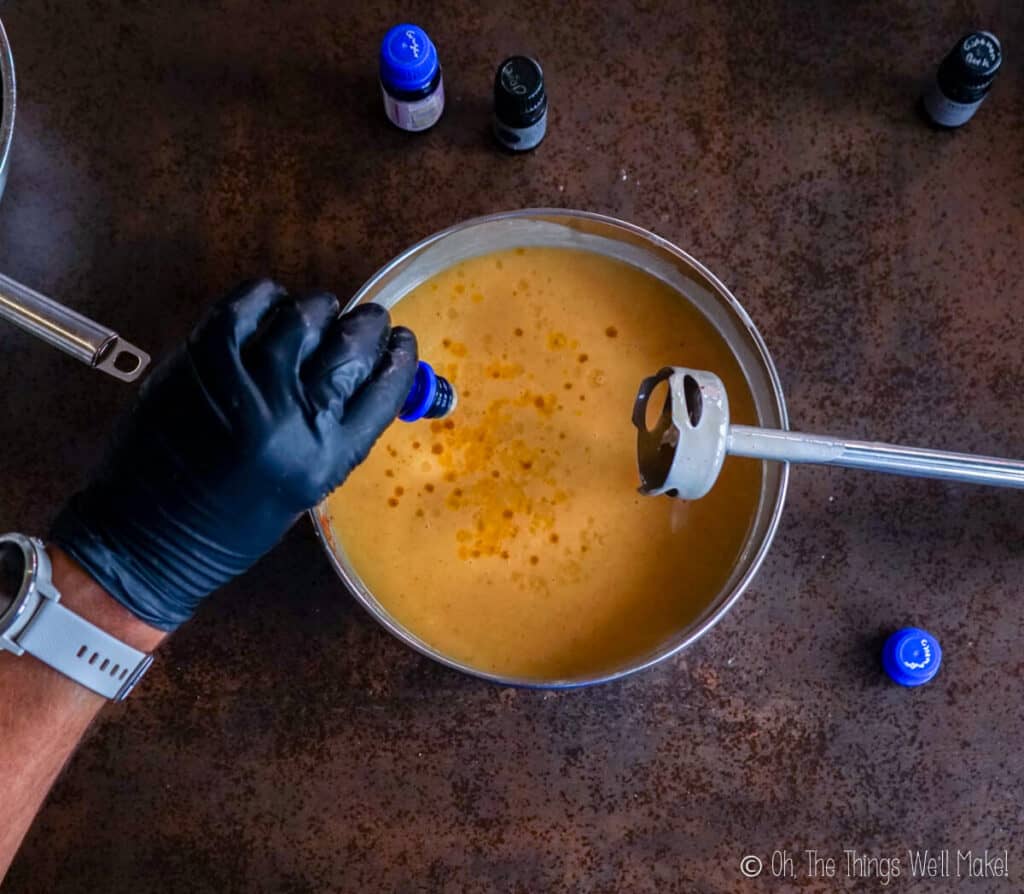
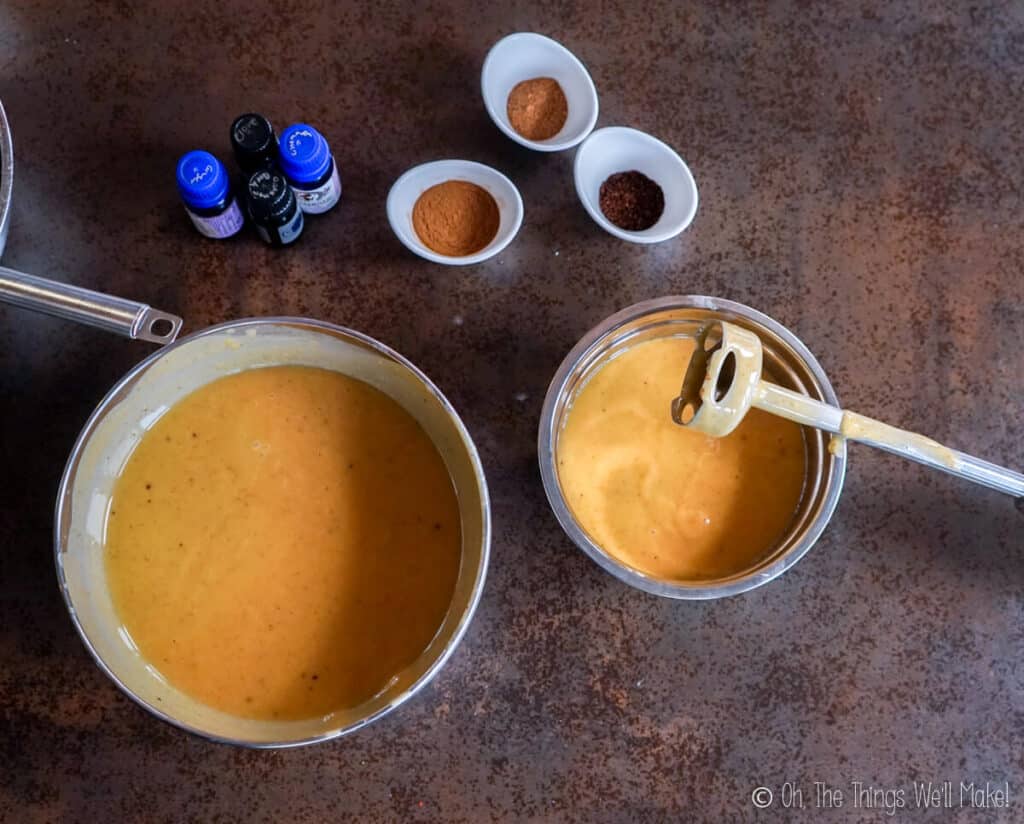
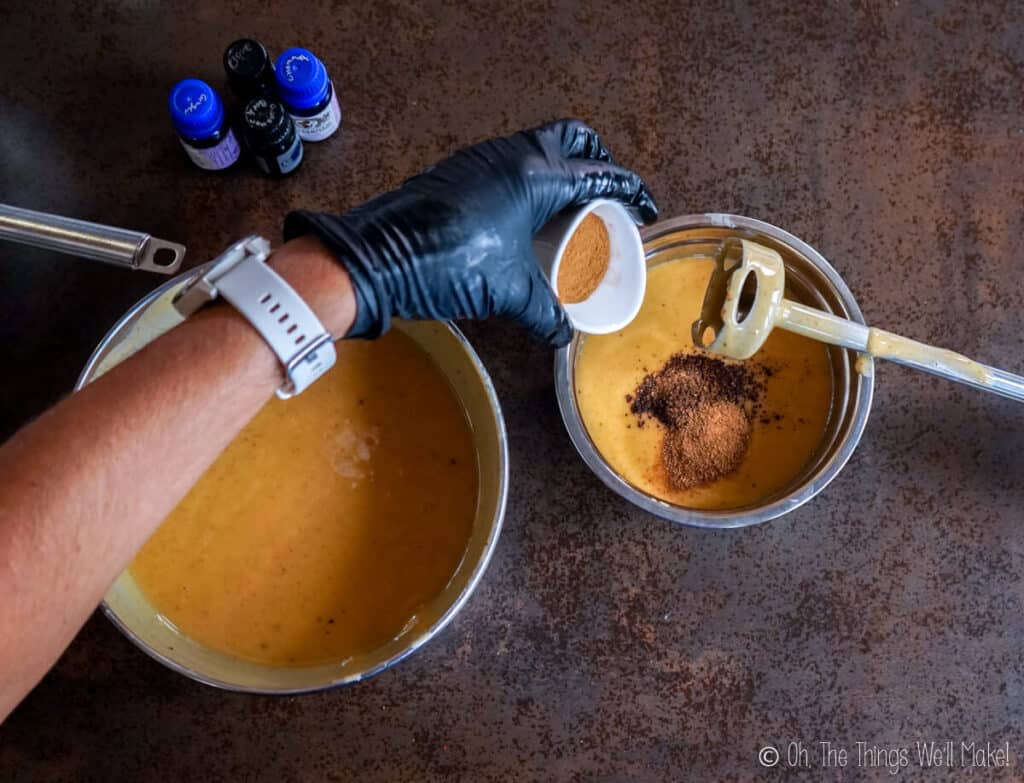
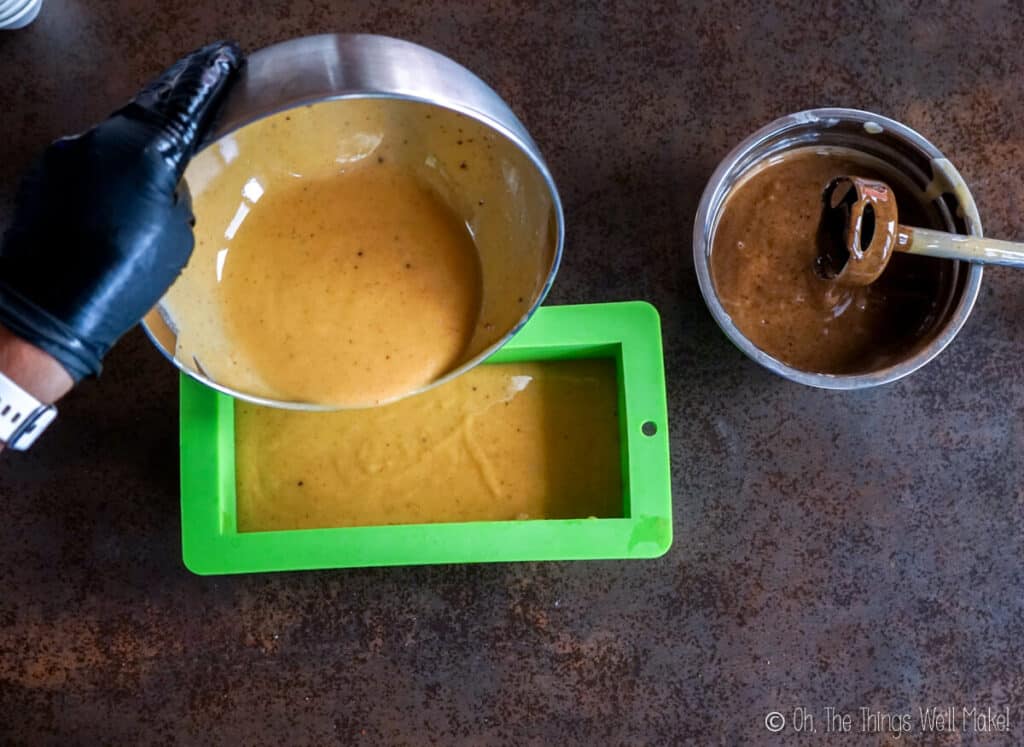
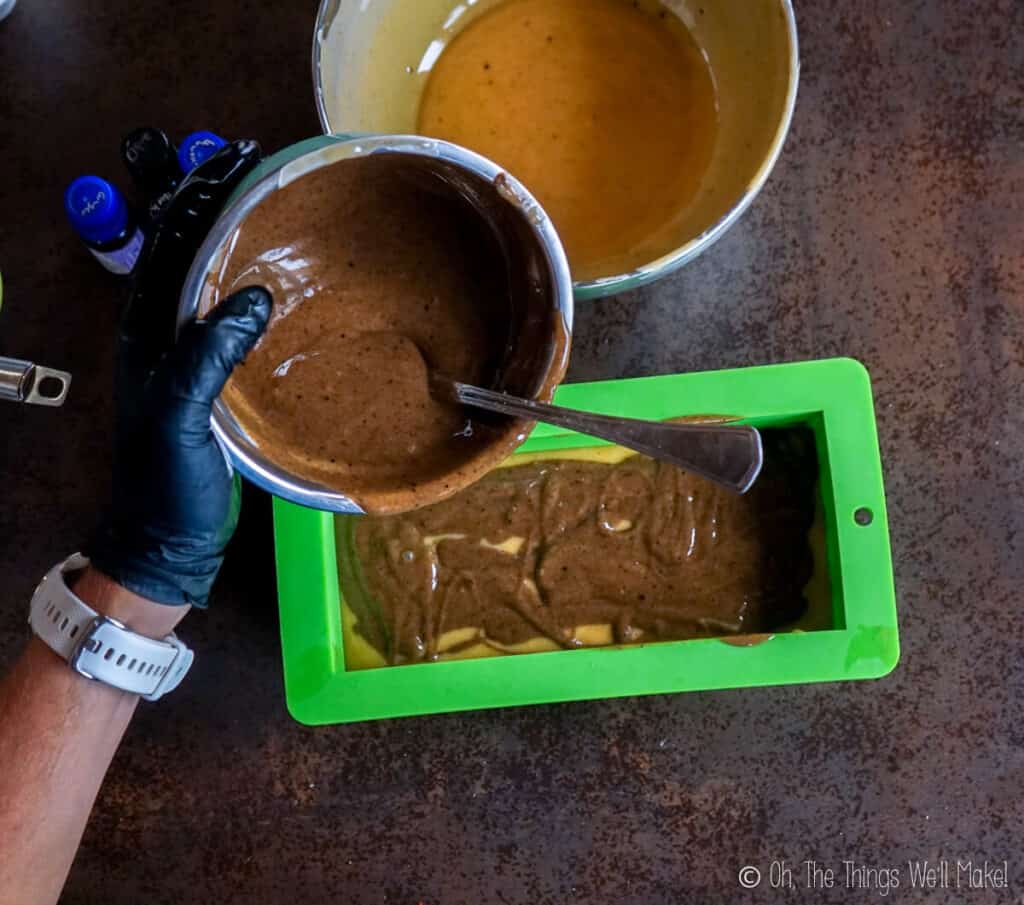
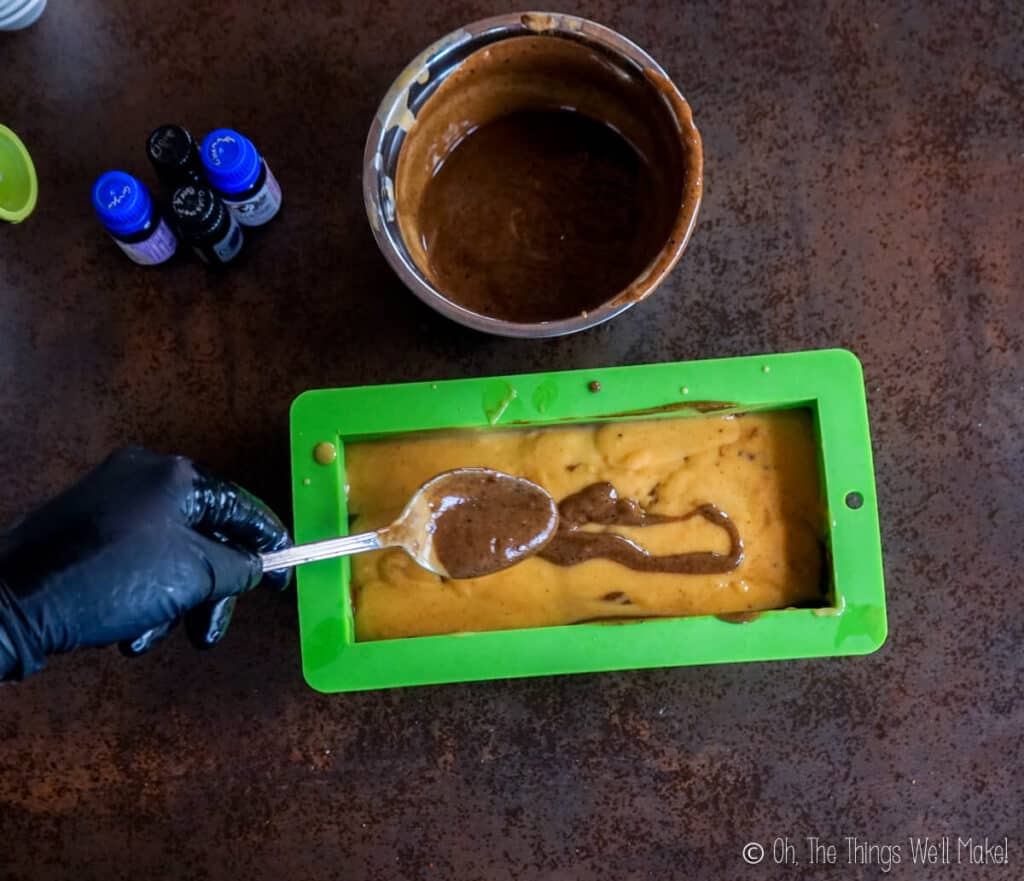
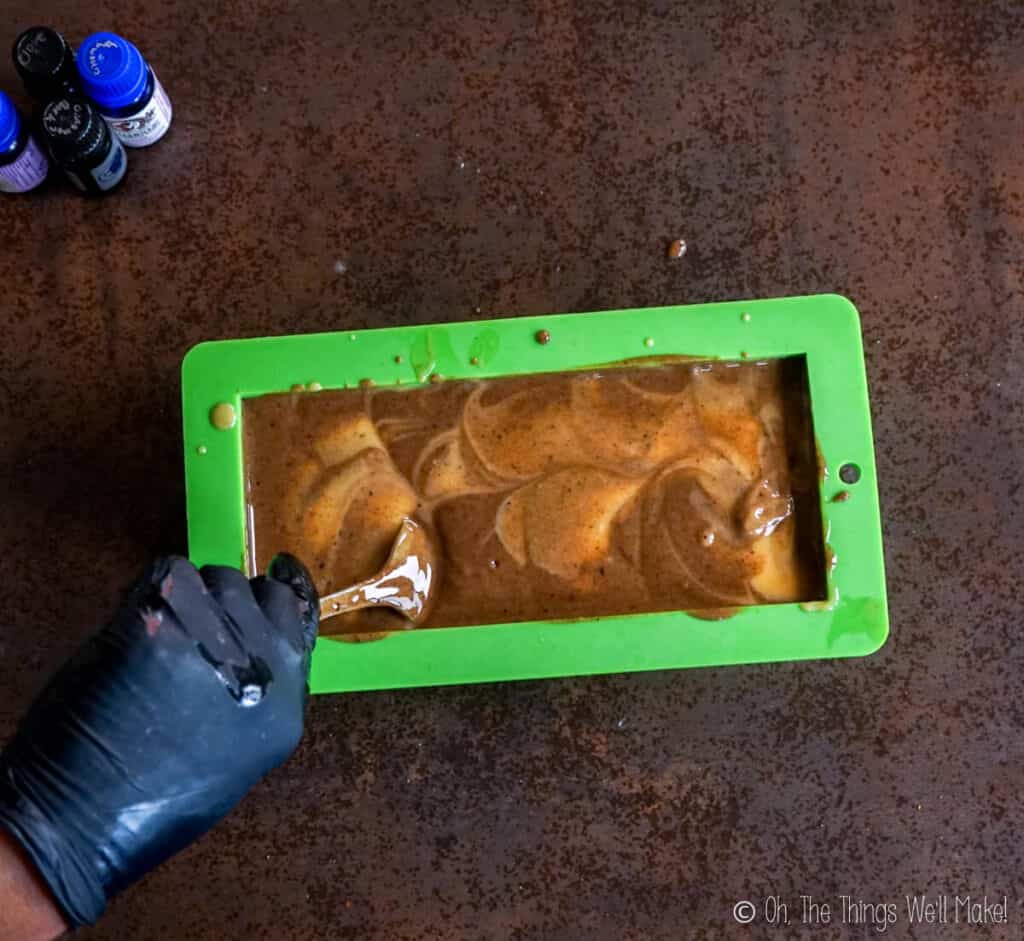
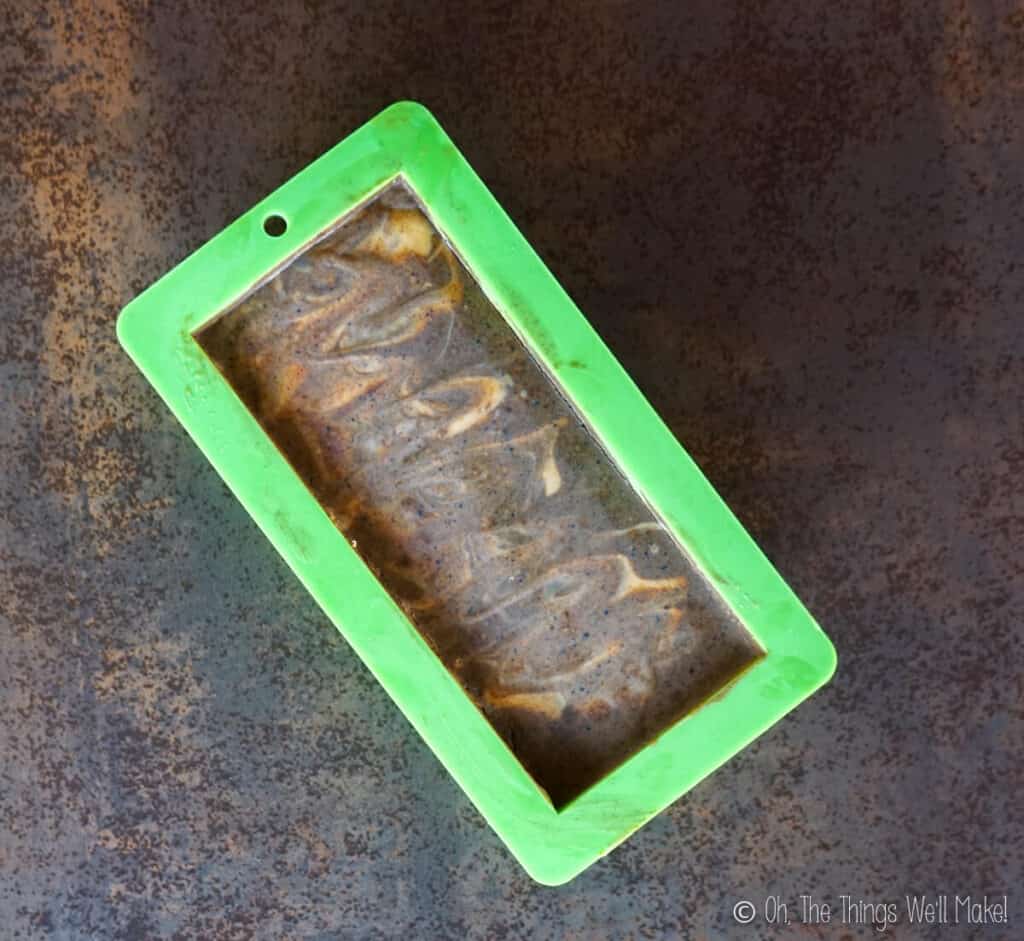
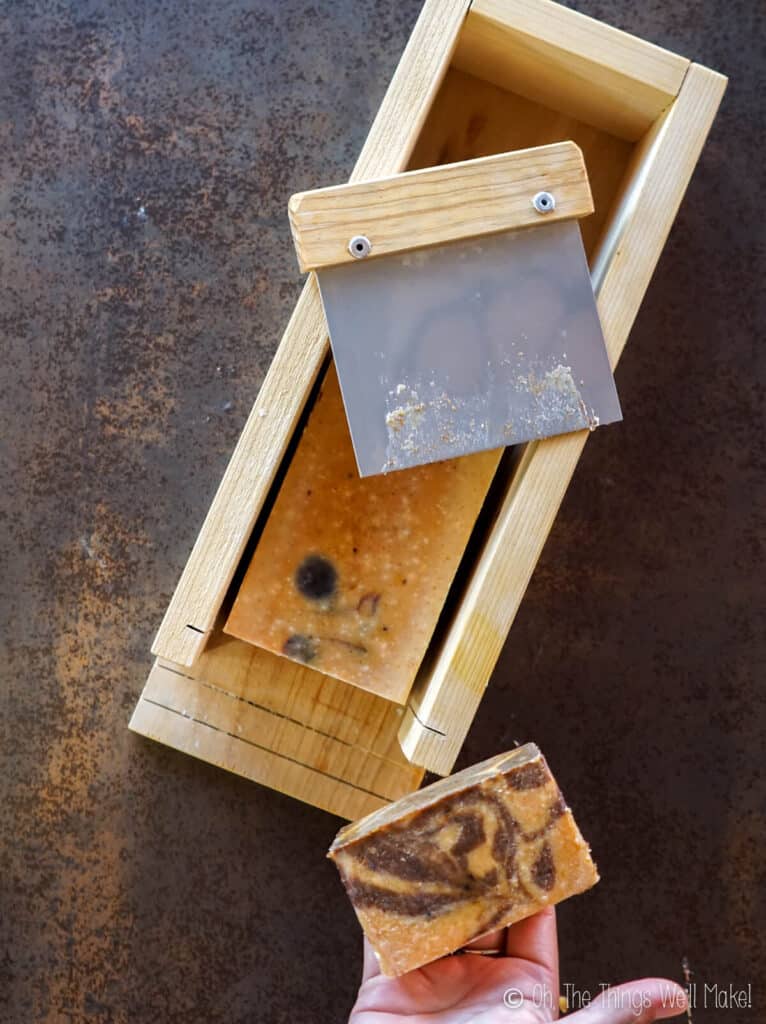
 Making an Easy, Basic Beginner Soap, and Then Making it Fun!!
Making an Easy, Basic Beginner Soap, and Then Making it Fun!!
Jodie
What oil could be used in place of coconut oil? I am allergic to coconut, and getting desperate enough to find soap/shampoo/conditioner without coconut/coconut byproducts to make my own.
Tracy Ariza, DDS
Hi Jodie,
You could try with an animal fat, but you’d have to adjust the recipe in a lye calculator. I have a post that explains how to use a lye calculator and one that talks about the oils in soap making that should help you adjust any soap recipe to use the oils that work best for you. In your case, I think it’s your best bet! It’s not as complicated as it sounds, and I think those 2 articles should really help you out. If you still have questions after reading them, let me know and I can try to help!
Karen
I just made this soap using 450 g coconut oil and 150 g olive oil for the oils. It would not go to trace. When I ran it through the SoapCalc it said 97.6 g lye. I used the 81 g. I also used frozen cow’s milk and white sugar since I didn’t have any brown sugar on hand. What happened?
Tracy Ariza, DDS
Hi Karen,
I am so sorry. I just updated this post with the new information, but I wrote the oils backward. It should have said 450g olive oil and 150g coconut oil. I just went in and fixed it right away. I made it that way on my last batch which is why I added in the option.
If you still have the batch, you should be able to save it by adding the extra 16-17g of lye. You’d have to mix it with a small amount of water and could then blend it into the rest of your mixture. If you want to evaporate some of the extra water, you could try hot-processing the soap. With your soap having a high concentration of coconut oil, though, it should be quite hard and probably wouldn’t need that.
I remember being very careful about double-checking the amount of lye, etc. to make sure I didn’t screw up the recipe for anybody. (I always do with these recipes.) I’m kicking myself right now for making such a dumb mistake and missing it. I really am very sorry, and hope you are able to fix the soap.
Nitesh Dagur
I just put the recipe in my soap calculator and it isnt giving me the desired values on scores for cleansing, hardness, INS factor or even in Iodine content. I am worried whether this soap will even harden.
Tracy Ariza, DDS
Hello Nitesh,
Yes, the soap does harden. It’s a very mild soap because it’s mostly olive oil-based. It has the coconut oil added to increase the cleansing and lather.
The values given by calculators like soapcalc can give you an idea- but really, it’s all about what the soap is actually like in person. I’ve made some soaps that should have been perfect according to soapcalc values and I didn’t personally like it.
This is more of a hand/body soap and not-so-much an all-purpose soap. It won’t have the same cleansing as a laundry soap, for example. 😉
If you went by only those values, nobody would ever make pure Castile soaps either, but some people absolutely love them for their mildness. I don’t really love pure Castile bar soaps, but do quite like this one. It’s basically a modified Castile (aka. Bastile soap).
It’s a modification of my easy beginner soap recipe. Many, many people have made that recipe over the years and have loved its simplicity and the final result-
So, I made 2 recipes that used that soap as the base, but added other ingredients so that people could see how easy it is to adapt a recipe to their liking. This is one of them and the Easy Gingerbread Soap is the other.
I really want to update this post with a video, though, and write more about that so that people can understand why I wrote this recipe as I did. Little by little, I’m making my way through all of my older posts and updating them with new information like that.
Aime
How much essential oils do I use? This is my first time making soap and I want to be sure I do it right!
Tracy Ariza, DDS
Hi Aime,
I usually rely on my sense of smell instead of measuring when making soap because it’s hard to measure accurately with such big batches. (I could weigh it separately on a jewelers scale and later add it in, but don’t generally do that for soap making.) I measure the EO’s in other recipes, but not soap, because I’m sure that I won’t add too much, since it would need a large amount to be unsafe. I generally make it smell a bit stronger than I feel it should be as it will lose some of its scent with time.
The nice thing about this recipe, though, is that the spices help scent the soap, so I’ve found that this recipe maintains its scent a lot more than any of the others!
Jen
If I leave out the Lye will it still lather?
Tracy Ariza, DDS
Hi Jen,
Without the lye, you can’t make soap. It’s a chemical reaction, and in the end, you don’t end up with any lye in your final product.
For more information about lye, read my post about if you can make soap without lye.
Anita
I tried your basic soap recipe and the results are curing now. Excited! I’m wondering, when you have time, could you please post on different ways to colour soap? Then I can just combine that with the basic recipe and then gift it to people. Thanks for all your great recipes!
Tracy Ariza
Hi Anita,
Awesome! Waiting for the first batch is always the most exciting! 🙂
Sure- it’s something I’d definitely like to do.
I’m planning on reorganizing and fixing up my whole soap making section this fall, and that’s definitely one idea I had. I can definitely make it more of a priority now that I know that there is interest.
I did some experimentation with coloring with spices and completely natural colorings, but would also like to give more options that include iron oxides and micas.
I also want to add another recipe to this post that includes more coconut oil to make it harder and lather more.
I personally love this recipe, but some people want a really hard, more cleansing bar so I’d like to give another option for those who don’t mind having a shorter working time.
Lisa J Christie
Can I use tap water instead of distilled water?
Tracy Ariza
Hi Lisa,
While it’s normally fine, I say to use distilled water because the tap water in some areas will have impurities that can interfere with the soap or make it so that it doesn’t keep as well. If somebody has issues with a recipe, I like to be able to rule out the tap water as a source of the issue. 😉
Suzette
I started reading this site in the hope that I could learn to make soap which did not incorporate palm oil. I was horrified to read the comments about using palm oil as an ingredient.
Before you use palm oil: please can everyone watch this You tube video about Rang Tan? https://www.greenpeace.org.uk/what-we-do/forests/rang-tan/
Tracy Ariza
Hi Suzette,
Sure, there are many wonderful soaps that don’t use palm oil! In fact, I’ve actually never used it in soap making. I don’t recall the comments you are talking about, but it’s still an ingredient I haven’t used. I think it’s very good to raise awareness about the problems in the palm industry. I will say, though, that it’s almost impossible to avoid all products that use palm. I buy in an Eco Supermarket that claims to have no palm products, but then they do have surfactants in their natural cleaning section and most items don’t specifiy which surfactants have been used. Many people aren’t aware that most of the more natural surfactants do have some palm in their origin. (And, of course, surfactants are just about everywhere.) I’m going to assume that they are probably selling many products sourced from palm without realizing it.
While not perfect, there are palm certifications so that you can make sure that the ingredients used are as sustainable as possible, which is what I look for when sourcing any surfactants that may have some palm in them.
zzz
there are also humans that depend on palm oil to survive. do your research before we put animals before human life and sustainability
Excelle
Thanks Zzzz
I’m Nigerian and major edible oil is palm.
My soaps use 6o-80%palm and they are great!
When people blast palm oil it makes me laugh because in my research about this, most of ‘their’ processed foods have palm in disguised forms. Plus the fact that we don’t have orang-utangs here and most other places that produce palm and it’s products.
Using one place/situation to blast an entire plant produce is highly ridiculous!
Tracy Ariza
Hi Excelle,
I think the problem with palm is that the demand got high and us “outsiders” came in and started to exploit it.
I don’t think most people would be against someone in an area that has always used palm continue to use it in a responsible way.
I think a lot of people avoid using palm because they don’t want to contribute to that exploitation.
While I don’t eat processed foods normally, so I don’t really probably ingest palm oil (although I don’t have a problem with non-hydrogenized palm health-wise), Many (most?) surfactants have some palm in them somewhere in the process. I try to always make sure that mine have been marked as being sustainably sourced with certification.
I guess it’s up to each of us to use what we feel comfortable with. I don’t avoid palm 100% (nor do most people who think they do. 😉 ), but I try to make sure I find from sustainable sources. (That doesn’t just apply to palm.)
I’m sure palm makes a lovely soap. I love coconut oil for soap, and I’d assume they would behave in a very similar way.
Vanessa
Thank you for this recipe! I have been wanting to make my own soap for quite some time. Your recipe was the first I tried and it came out AMAZING! At first I thought the clove scent was too strong but after 6 weeks of curing, it is perfect!
Tracy Ariza
Hi Vanessa,
Thank you so much! (And thank you for letting me know how it turned out!) I’m so happy to hear it turned out well for you!
Yes, fragrances definitely mellow with time, and in most cases, with natural scents, it’s hard to get them to stay around. Luckily these tend to be pretty fragrant and last well.
Trixie
Hi! This may sound like a dumb question, Im from the Philippines and I wonder when you you said to dry out the soap, do you mean just indoors? It gets really hot out here and I’m thinking if i left it out under the sun, will that help in making it cure faster? Thank you so much!
Tracy Ariza
Hi Trixie,
I dry mine indoors.
I’m not sure what would happen in the sun, but you wouldn’t really lower the cure time just by having it dry more quickly. The cure time is partly about drying time, but it is also about giving the crystalline structure of the soap time to restructure itself.
In any case, you are able to use the soap before then- it just will improve with time.
After a few days, normally the saponification process will have finished, so it’s safe to use your soap soon after having made it. It’s all about allowing it to improve. That doesn’t mean that you can’t use it earlier if you are feeling impatient. 😉
Giselle
Hi Tracy,
Your soaps are wonderful and very inspirational!
In your recipe you call for 100ml of water and not distilled water. does it matter if it is distilled or not when it comes to adding milk to the recipe?
Tracy Ariza
Hi Giselle,
I should probably update the recipe and say to use distilled water. When I first made soaps- including this soap, I only used our filtered water for drinking, and I never had any problems. In most cases, you can use regular filtered water for making bar soaps. The problem is that some people will have water that will have certain minerals or other substances that may give unwanted reactions or that “contaminate” the soap in some way or another.
I normally like to say to use distilled water, mostly just to be able to rule out any problems like that if the person is having issues.
So, while in most cases, it’s OK to use regular water, I still feel better about using distilled when possible.